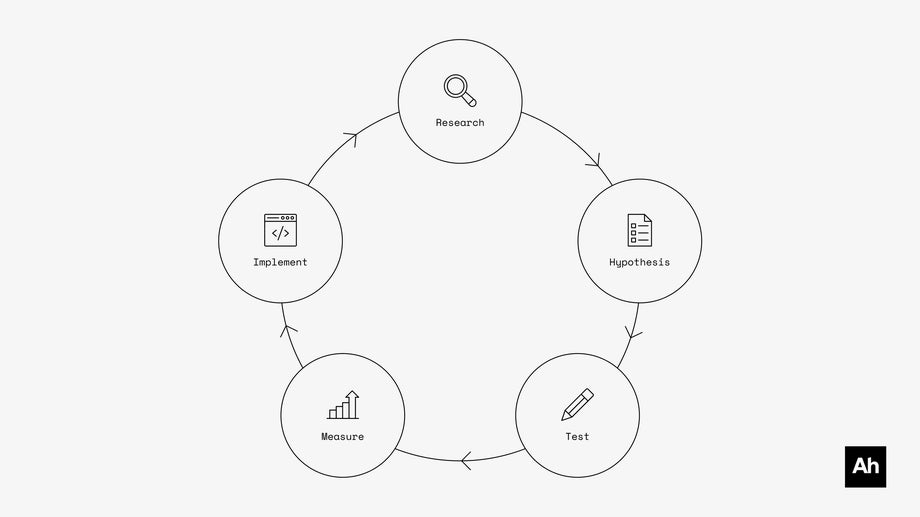

28.06.20236 mins read
Conversion Rate Optimization (CRO) is the process of increasing the number of people who take a desired action when visiting your website or app. Whether that’s making a purchase, completing a sign up, opening an account or requesting a callback. Optimization plays a fundamental role in improving digital performance and increasing revenue.
At All human we have a dedicated team of CRO professionals committed to driving conversions for all our clients. My colleague Sarah Lachapelle explains the comprehensive CRO programme we built and refined in-house over the years in Why conversion rate optimisation is critical for digital channel growth. A process for which we recently won Global CRO Agency of the Year.

However, despite its obvious benefits, investment into ongoing analysis and optimisation is something that brands often overlook or de-prioritize. In this blog, I look at the role of Conversion Optimisation programmes in converting visitors to customers and why it is an essential component for every brand to consider in today’s competitive market.
Don’t waste any opportunities - you are already spending a lot of money and effort on getting people to your site, but what happens then? At what point are users dropping off and why? Conversion optimization focuses efforts on getting the most from traffic already on site, whether it is coming from organic or paid channels such as search engines, paid ads, social or email.
Optimizing this traffic allows businesses to generate more conversions which means more sales, sign-ups, or referrals online. Ultimately it can mean more sales without having to invest further in traffic generation and now your marketing team can look at other ways to maximise your digital marketing spend.
In addition, focusing on site conversion metrics will help you understand which channels are performing best so that you can make the necessary adjustments to both proposition and budgets.
Introducing a change to your site or app that is not grounded in data or user research could have severe consequences both in terms of the potential impact on business metrics and user experience. Making this even more complex and tricky is when several fundamental changes are introduced at once. Now you have no idea which change is the source of adverse trends or outcomes and it can take time to identify the source.
However, by experimenting, brands can test ideas first with a group of real website visitors before investing time and effort to change the website code permanently. This is a relatively low-risk approach as test variants can be run for a short time until they become statistically significant. Also, most A/B testing tools allow tests to be stopped instantly if they are having a particularly negative impact on core metrics.
And even if the experiment is deemed unsuccessful against primary metrics set, it still provides an excellent opportunity to learn even more about your online visitor behaviour. We firmly believe that failed tests should be embraced as we always learn from them and hypothesis again.

One of the key trends that emerged from All human’s proprietary research, All human Digital Pulse 2022, into online shopping habits and behaviours was the overwhelming desire for a seamless website experience and frictionless journey.
Aside from driving monetary metrics up, such as sales, revenue, or average order value, a focus on conversion optimisation can also improve customer experience (CX) and overall satisfaction with a brand. With so many alternatives just a click away, customer satisfaction is a pivotal driver for a brand’s overall success
As part of our Digital Performance process, we focus on identifying bottlenecks in online customer journeys and ideate variations of design solutions that we then test through experimentation platforms.
You have already invested in marketing campaigns to get people to your site. Now you want to ensure that any activities that optimise conversions onsite are cost-effective. Conducting basic A/B testing can be relatively inexpensive and can be done in parallel with other core projects.
Taking subjectivity out of the equation and pursuing objective data-based decision-making also means that you can reduce the amount of time spent debating or discussing changes internally. Resources can instead be freed up to ideate and build out the experimentation roadmap. At the same time, product backlogs can become more impactful too. Changes are only given the green light once they are validated through experimentation.
This follows my first point- you’ve spent the money on ads, digital marketing campaigns, website design and app developments. Now it’s about making sure you get the highest returns. For marketers, it is also about proving that what they are doing is working. Everyone is working to tight KPIs to demonstrate both the strategy they are undertaking is the right one and that they are having a measurable impact on business and improving the overall profitability of your digital channel.
Through its very actions and tools, CRO delivers continuous uplifts to ensure that brands achieve these goals.



